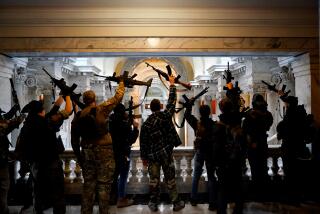Add at least 57 to the number of gun-related deaths tied to the Sandy Hook mass shooting

The attack in Newtown, Conn., claimed the lives of 20 schoolchildren and six adult staff members at Sandy Hook Elementary School. (Dec. 7, 2017) (Sign up for our free video newsletter here http://bit.ly/2n6VKPR)
One often-overlooked fact about mass shootings is that they have been very good for the gun business. Americans’ anxieties are stoked both by the random violence itself and the ensuing debates over gun control. Customers, including some who’ve never owned a gun, race to buy weapons they fear may be denied them down the road. And gun sales soar.
But the aftermath of a mass shooting does not appear to be very good for Americans’ safety. New research suggests that the increased availability of firearms after a mass shooting exacts a deadly toll of its own.
That toll falls heavily on children, according to the study, which links the spike in gun sales following a mass shooting with an increase in fatal accidents involving firearms.
To reach that conclusion, researchers zeroed in on the five-month period following the Dec. 14, 2012, shootings in Newtown, Conn., that claimed the lives of 20 schoolchildren and six adult staff members at Sandy Hook Elementary School.
In addition to the expected number of guns sold in a typical five-month period, the study’s authors found that about 3 million additional guns were sold following the Sandy Hook shootings. And beyond the expected number of accidental gun deaths in the United States, they estimated that at least an additional 57 fatal gun accidents — and as many as 66 — occurred. Somewhere between 17 and 22 of those accidental deaths took the life of a child.
The analysis, published Thursday in the journal Science, is the latest in a crop of studies that look at the public health impact of firearms.
“This is part of this blossoming in gun research,” said Duke University emeritus professor Philip J. Cook, a pioneer in the field of firearms injury research who wasn’t involved in the new study.
The line between increased gun sales and accidental shootings is by no means a direct one. But the research strongly suggests that the behavior of gun owners and gun buyers in the wake of the Sandy Hook shooting contributed to a rise in accidental gun deaths.
The study’s authors — health economists from Wellesley College and from the National Bureau of Economic Research in Massachusetts — used several measures to gauge Americans’ increased “gun exposure” in the wake of Sandy Hook.
They saw a spike in presumptive gun sales, gleaned from a spike in the background checks required for most sales. They also tallied increases in Google searches about gun-buying and gun-cleaning. That’s evidence, they suggest, that gun owners were bringing existing guns out of storage and that both established and prospective gun owners were preparing to bring a new firearm into the home.
Scouring a federal database of recorded deaths in the United States, researchers found “evidence of a spike in accidental firearm deaths to children exactly at the time of the increase in gun sales after Sandy Hook.”
The bump in accidental deaths didn’t look like a random blip: Researchers could find no jump of similar magnitude in any of the other time periods they searched. Further confirmation came from their statistical projections of the relationship between the number of guns in the U.S. and fatal gun accidents, which were a near-perfect match for the actual number of deaths.
Another piece of data further strengthened the argument that increased gun exposure boosted fatal gun accidents: When the researchers mapped the increases in accidental gun deaths recorded, they found them concentrated in states where the post-Sandy Hook spike in gun sales was very high.
“This is the pattern we would expect to see if those who purchase guns (and perhaps those who remove guns from storage) are more likely to succumb to accidents until those guns are stored in a safer environment,” wrote the authors, Phillip B. Levine and Robin McKnight.
Levine and McKnight added that the findings support the passage and enforcement of safe gun-storage laws and underscore the value of having physicians counsel their patients about ways to reduce firearms injuries.
Stephen Teret, who directs Johns Hopkins University’s Center for Law and the Public’s Health, called the new study “a methodological tour de force.”
But Teret, a pioneer in firearms injury research, said the researchers’ suggestion that better gun-storage practices would drive down such injuries “represents a departure from their data.”
“There still aren’t good data that efforts to educate people to store guns more safely end up reducing gun deaths,” Teret said. “And there are better ways to reduce gun deaths than to tell people to be more careful. Those include changing the design of these guns so kids can’t operate them.”
The study’s results extend research that has found consistently higher rates of firearms deaths — including suicide, homicide and accidents — among those living in households with a gun or who have ready access to a gun. Higher rates of gun ownership across different states and countries also have been strongly linked to a higher incidence of firearms-related injury and death.
The new findings fit neatly with research published in October showing that, in the weeks following gun shows in Las Vegas, gun deaths and injuries in nearby California towns rose by 70%.
And they dovetail with a study published in May, which was the first to rigorously measure the spike in gun sales after mass shootings. Published in the Annals of Internal Medicine, that study found a 53% boost in gun sales in California in the six weeks following the Sandy Hook shootings and a 41% increase over normal sales levels in the state in the six weeks after the December 2015 San Bernardino shootings in which 14 were gunned down.
The California data culled from that study suggested that 59% of Californians’ additional gun purchases after Sandy Hook were made by first-time firearm buyers.
By linking increased gun exposure to heightened rates of accidental gun deaths, the authors of the new study in Science are making an early effort to weave together the disparate threads of recent research. Their findings offer evidence — indirect, though it may be — that fatal accidents are more common when first-time owners bring home a gun, as well as when gun owners haul out their guns to clean them, check them or make room for a new purchase. They also suggest that this kind of firearms “churn” takes place more often in the wake of mass shootings.
“The idea this shock to the system added to gun sales is certainly plausible and seems like the beginning of a causal story,” said Cook, who has studied the economics of guns and crime for decades.
It’s hard to link two streams of data — on the availability of guns and the behavior of gun owners — and draw firm conclusions about how and why firearms injuries occur, Cook said.
“I love the spirit of this article, which was to try to cut through that problem,” Cook said.
And there may be more to come, he added.
After 1996, when a law barred the use of some federal funds for firearms research, a once-vibrant field of study went virtually dormant, he said. Now, prompted by a surge in private funds, public concerns and academic interest, Cook predicted that “more top researchers are going to gravitate to this area of research.”
MORE IN SCIENCE
America, it’s time to get ready for the flu
Scientists use CRISPR to turn genes on without editing their DNA
Found: The oldest known supermassive black hole in the universe







